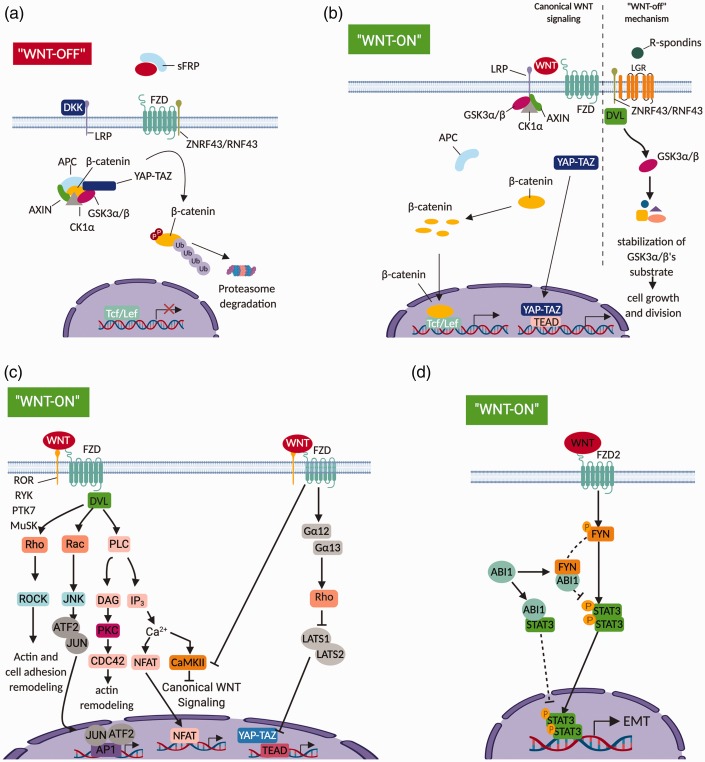Figure 2.
Wnt signaling pathways. (a) In the absence of Wnt molecules, the canonical Wnt/β-catenin pathway is inactivated due to the existence of the β-catenin destruction complex, which is made of scaffold protein APC, Axin, Hippo pathway proteins YAP–TAZ, and kinases CK1a, GSK3a/b. The destruction complex mediates β-catenin phosphorylation for its following proteasome degradation. The canonical Wnt pathway can be negatively regulated by extracellular Wnt-binding protein like sFRPs, or by proteins like Dkk1 that downregulate membrane co-receptors (LRP5/6) of the canonical pathway. (b) In the presence of canonical Wnt molecules, Wnt binding to Fzd receptors promotes dimerization of the Fzd receptor to its co-receptor LRP5/6. Then, LRP5/6 recruits components of the β-catenin destruction complex to its cellular carboxy-terminal tails, which dissociates the destruction complex and leads to β-catenin stabilization and accumulation in cells to allow β-catenin nuclear translocation for its mediated downstream transcriptional responses. Also, the dissociation of the destruction complex prevents GSK3a/b’s substrates phosphorylation and degradation, which is called Wnt–STOP mechanism. (c) In the presence of non-canonical Wnt molecules, Wnt binding to Fzd receptors promotes dimerization of the Fzd receptor to variable types of co-receptors for recruitment of the adaptor protein DVL. The recruitment of DVL triggers multiple β-catenin independent non-canonical downstream events to mediate cellular actin remodeling processes, variable types of transcriptional responses, or canonical Wnt pathway downregulations. (d) For multiple types of cancers, a novel Wnt5a-mediated non-canonical pathway is found to mediate the EMT. In this pathway, Wnt5A binding to Frizzled-2 receptors activates Src family kinases Fyn by promoting its phosphorylation. Then, Fyn activates the STAT3 to trigger STAT3-mediated EMT processes. This non-canonical pathway is negatively regulated by Abl interactor 1 (ABI1). ABI1 can directly interact with either Fyn or STAT3, although roles of these interactions in regulating the Wnt5a–STAT3 pathway remain unknown. (A color version of this figure is available in the online journal.) Source: Figure modified from Wang et al.29 and Murillo-Garzon and Kypta.30
DVL: Dishevelled; EMT: epithelial–mesenchymal-transition; JNK: JUN-N-terminal kinase; LATS1: larger tumor suppressor 1; LATS2: larger tumor suppressor 2; LGR: leucine-rich repeat-containing G-protein coupled receptor; LRP: lipoprotein receptor related protein; RNF43: ring finger protein 43; ROCK: Rho-associated kinase; sFRP: secreted frizzled related protein; ZNRF3: zinc and ring finger 3.

